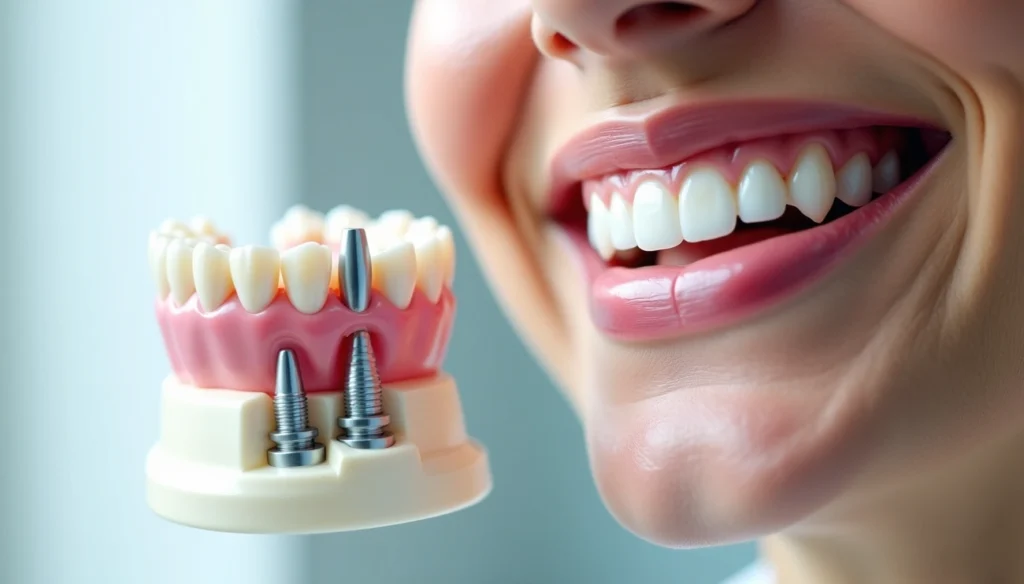Patients who choose between zirconia and titanium dental implants make a decision that shapes their oral health for decades. Titanium dental implants last for 25-30 years or more without issues. A Swedish researcher Per-Ingvar Brånemark’s discovery of osseointegration in the 1960s made titanium implants the gold standard in dentistry for more than 50 years.
Zirconia dental implants showcase the newest developments in implant dentistry and give patients a metal-free option instead of traditional titanium. Each material comes with its own benefits and drawbacks. Titanium implants show remarkable results with a success rate of approximately 95-98% and decades of clinical research back this up. Zirconia implants cost about 20-30% more than their titanium counterparts. Many patients prefer zirconia’s natural appearance and durability.
This piece gets into the actual differences between these dental implant materials, their performance metrics, and which option suits specific patient needs best. Readers will learn about everything from biocompatibility concerns to esthetic factors to help them make the right choice for their dental restoration experience.
Understanding Dental Implant Materials
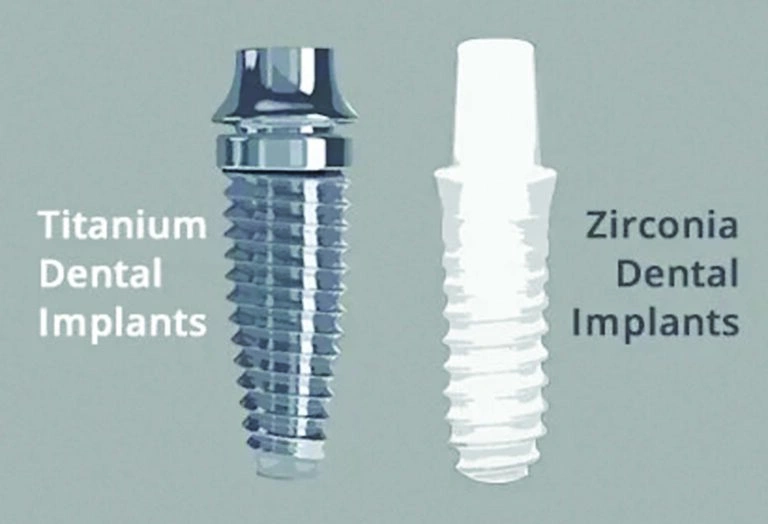
Image Source: Neighborhood Gazette
Dental implants are a breakthrough in modern dentistry that gives patients a permanent solution for missing teeth. Learning about implant materials helps patients make better decisions about this life-changing procedure.
What are dental implants made of?
Dental implants are mainly made of titanium or zirconia materials. Titanium remains the most used material because it creates a permanent fixture with bone. Most titanium implants use titanium alloys instead of pure titanium to make them stronger and safer. On the other hand, zirconia (zirconium dioxide) offers a newer metal-free alternative that shows great promise. On top of that, it features a one-piece construction compared to titanium’s three-piece design, which can make surgery simpler.
The role of osseointegration in implant success
Osseointegration is the key biological process that makes dental implants possible. This process creates a direct structural and functional connection between living bone and the implant surface. Swedish researcher Dr. Per-Ingvar Brånemark found this by accident in the 1950s while studying blood flow in bones. The bone around the implant heals and grows to hold it firmly in place. This usually takes three to six months. Success depends on many factors like the implant material’s biocompatibility, surface design, bone quality, proper healing, and correct loading conditions.
Titanium vs zirconia: a quick overview
These materials each have their own benefits:
- Survival rate: Titanium implants show a statistically higher survival rate (77.6%) compared to zirconia (70.3%)
- Bone integration: Titanium implants lose less bone (0.18 mm) than zirconia implants (0.42 mm) after 12 months
- Esthetics: Zirconia looks better, especially for front teeth, because its white color won’t show through thin gums
- Biocompatibility: Both materials work great with the body, but zirconia might be better for people with metal allergies
Titanium has been the gold standard for decades with success rates above 90-98%. Zirconia is becoming more popular because it looks better and doesn’t cause allergic reactions.
Titanium Implants: Strengths and Limitations
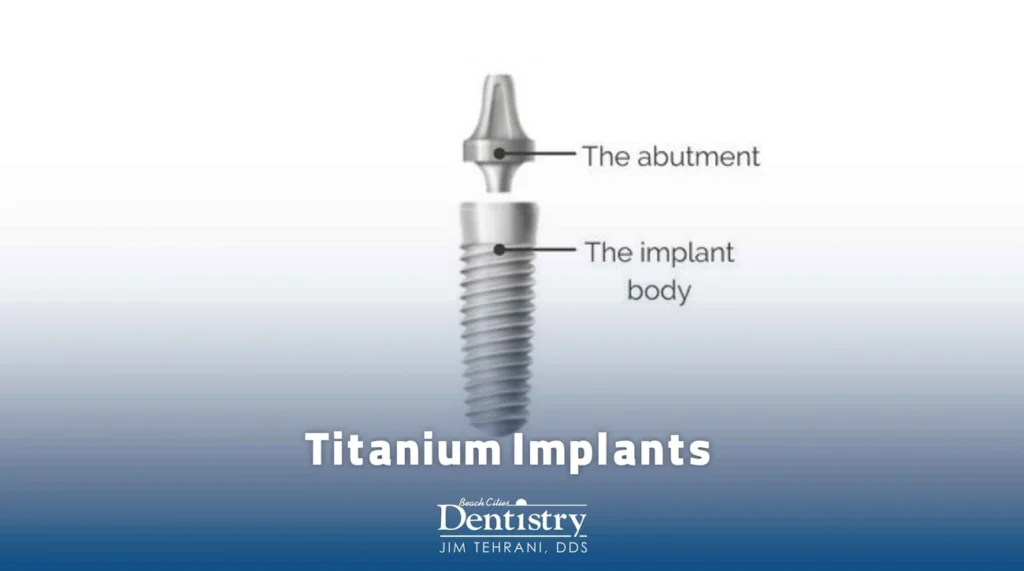
Image Source: Beach Cities Dentistry
Titanium has been the gold standard in dental implantology for over five decades. It gives patients reliable tooth replacement options with great clinical outcomes. Knowing its strengths and limitations helps patients and dentists make better decisions about implant materials.
Proven long-term success and durability
Titanium dental implants last an incredibly long time. Their survival rates reach 95-98% over ten years. The largest longitudinal study shows that 4 out of 5 titanium implants work well even after 20 years. A big study that looked at 10,871 implants found amazing survival rates: 98.9% at 3 years, 98.5% at 5 years, and 96.8% at 10 years. These implants are so durable because titanium’s strength lets it handle daily biting and chewing forces without breaking down.
Biocompatibility and rare allergy concerns
Titanium’s biocompatibility plays a huge role in implant success. The metal creates a passive, stable oxide film that naturally merges with jawbone through osseointegration. Your body rarely sees titanium as a foreign object, so the risk of rejection and inflammation stays low. Titanium allergies are very rare – studies show that only about 0.6% of patients have any sensitivity. People who react to titanium might notice inflammation, pain, or red tissue. These reactions are usually Type IV hypersensitivity responses.
Two-piece design flexibility
Most titanium implants come in two pieces: a fixture that goes into the jawbone and an abutment that connects to the crown. This design lets dentists customize the final restoration and adjust angles for the best crown position. The design works well in different clinical situations and works with teeth of all types, no matter the bone density or location.
Potential esthetic drawbacks in thin gums
Titanium works great but can have some appearance issues. The dark gray color might show through if you have thin or receding gums, especially in front teeth where looks matter most. You might see a grayish-black line near the gum edges, which can make the implant look less natural. This becomes more noticeable for people with high smile lines or thin gum types. Sometimes dentists recommend using materials like zirconia for front teeth instead.
Zirconia Implants: Benefits and Considerations
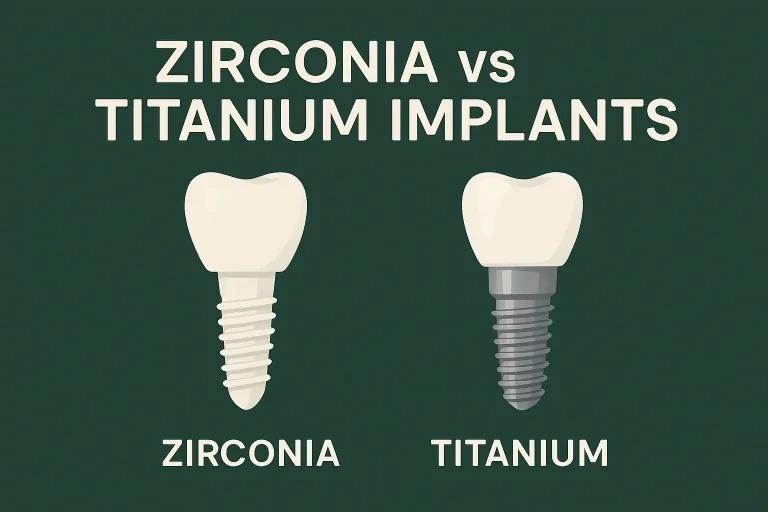
Image Source: Dentist in North York
Zirconia has become a compelling choice for dental implants over the last several years. It offers clear advantages and important factors patients should think about when looking for tooth replacement options.
Metal-free and biocompatible option
Zirconia dental implants give patients a completely metal-free solution that works great for those with metal allergies or sensitivities. These implants’ hypoallergenic nature prevents allergic reactions and helps tissue heal well. On top of that, it stays bioinert, which means it doesn’t react chemically with soft tissues and reduces inflammation.
Superior esthetics for front teeth
Zirconia’s white color looks just like natural teeth and blends in perfectly, especially when you have to work on the “esthetic zone” or front teeth. Unlike titanium implants that can show gray through thin gums, zirconia keeps looking natural even as gumlines recede. This esthetic benefit becomes even more valuable for patients with thin gingival biotypes.
Lower plaque accumulation and inflammation
Zirconia’s smooth surface dramatically reduces bacterial plaque buildup. Research shows that zirconia prostheses have much less plaque than titanium at every checkpoint. The reduced bacterial attraction might lower peri-implantitis risk and help implants last longer.
Design limitations and fracture risk
All but one of these zirconia implants come in a one-piece design, which limits flexibility in placement and angle adjustments. This makes customization tough for certain clinical cases. The implants also have a higher chance of fracturing, especially with narrow diameters (3.0-3.3 mm) or in patients who grind their teeth or have strong bite forces.
Higher cost and limited long-term data
Zirconia implants cost 20-30% more than titanium ones, with prices from $1,500 to $7,000 per implant. While early results look promising, zirconia doesn’t have the largest longitudinal study data that titanium has from years of use.
Comparing Performance: Which One Lasts Longer?
Patients want to know how long their dental implants will last before they choose an option. Several factors determine the lifespan of different materials based on clinical performance data.
Survival rates and clinical outcomes
Research shows titanium implants have a slight edge in survival rates. Studies indicate 97.7% survival for titanium compared to 93.8% for zirconia implants. Titanium implants show impressive durability with 98.8% survival over 10 years, while zirconia implants achieve 95% over 7 years. All the same, recent meta-analyzes point to similar performance levels, and zirconia implants reach a 97.2% five-year mean survival rate.
Bone loss and tissue response differences
Titanium proves better at preserving bone structure in terms of marginal bone loss. Measurements reveal titanium implants have 0.18mm bone loss compared to 0.42mm with zirconia at 12 months. Zirconia’s advantages show up in soft tissue response, as studies show lower inflammation rates and less bacterial attachment.
Strength under pressure: molars vs front teeth
Location in the mouth substantially affects how implants perform. Titanium works best for molars that handle up to 200 pounds per square inch of pressure. Zirconia proves to be a great choice for front teeth where looks matter more than extreme strength.
Cost-effectiveness over time
Titanium implants provide better value upfront and cost 20-30% less than zirconia options. Both materials need similar upkeep, and prosthetic crowns usually need replacement every 10-15 years whatever the implant material.
Conclusion
Patients and dentists must weigh several factors when choosing between titanium and zirconia dental implants. Titanium implants without doubt show excellent longevity. Their survival rates reach 95-98% over ten years. These implants’ proven track record extends beyond five decades, which makes them a reliable choice for many patients. All the same, zirconia implants offer compelling advantages, especially when you have metal sensitivities or esthetic concerns in the anterior region.
The implant location should guide material selection. Titanium excels for posterior teeth where strong bite forces just need superior mechanical properties. Zirconia works best for front teeth where looks matter most. It eliminates the risk of grayish discoloration through thin gum tissue.
Each patient’s specific factors play the most important role in this decision. People with metal allergies or thin gingival biotypes benefit more from zirconia’s biocompatible, metal-free composition. The patients who want budget-friendly, clinically tested options with maximum design flexibility often find titanium meets their needs perfectly.
Cost remains a key consideration. Zirconia implants cost 20-30% more than titanium options, though both need similar care long-term. This price difference can affect decisions, especially when patients need multiple implants.
Titanium stands as the gold standard based on the largest longitudinal study evidence. Yet zirconia grows more popular as manufacturing techniques improve and research confirms its performance. Both materials can serve for decades when properly placed and managed to keep. The best choice depends on balancing clinical needs, esthetic goals, and individual patient factors rather than declaring one material better than the other.
FAQs
Q1. Are titanium or zirconia dental implants better? Both materials have their strengths. Titanium implants offer proven long-term success and durability, while zirconia implants provide superior esthetics and are metal-free. The best choice depends on factors like implant location, patient-specific needs, and budget considerations.
Q2. What are the main advantages of zirconia dental implants? Zirconia implants are metal-free, biocompatible, and offer superior esthetics, especially for front teeth. They also show lower plaque accumulation and inflammation compared to titanium implants.
Q3. How do titanium implants compare to zirconia in terms of longevity? Titanium implants generally have slightly higher survival rates, with studies showing 97.7% survival for titanium versus 93.8% for zirconia. However, recent research suggests comparable performance, with zirconia implants achieving a 97.2% five-year mean survival rate.
Q4. What are the potential drawbacks of titanium dental implants? While rare, some patients may experience allergic reactions to titanium. Additionally, the dark gray color of titanium can sometimes become visible through thin or receding gum tissue, particularly in the front teeth area, which may compromise esthetics.
Q5. How do costs compare between titanium and zirconia implants? Zirconia implants typically cost 20-30% more than titanium implants. However, both materials require similar long-term maintenance, with prosthetic crowns usually needing replacement every 10-15 years regardless of the implant material used.

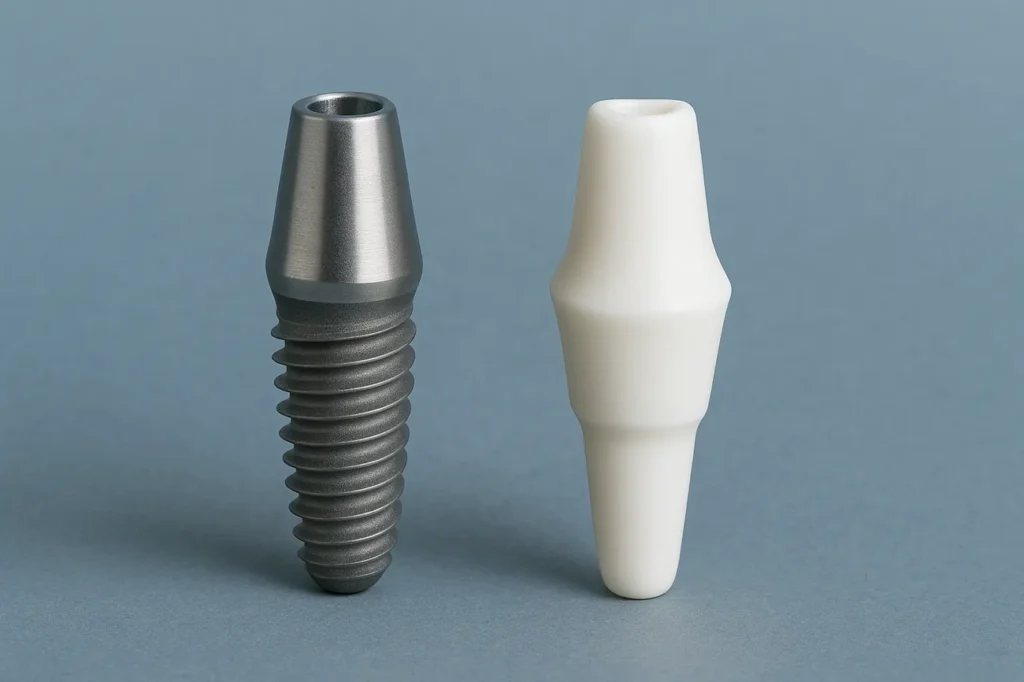
![Mini Dental Implants vs Traditional: Expert Guide for Better Choice [2025]](https://dentalimplantinsights.com/wp-content/uploads/2025/08/Mini-Dental-Implants-vs-Traditional-1024x584.webp)
